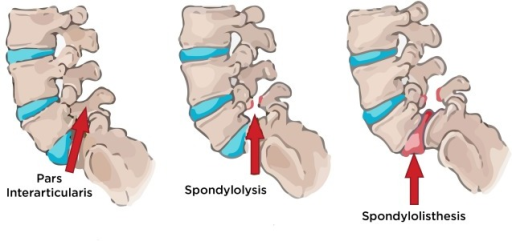Last Updated on October 28, 2023
What is Pars Interarticularis?
The Pars Interarticularis is a special region of the lamina between the superior and inferior articular processes. The term literally means part between the articulations in Latin language and is kind of bony bridge that joins these two upper and lower facets.
 Thus one vertebral has two pars interarticularis.
Thus one vertebral has two pars interarticularis.
Thus facet joints above are connected to the joints below in one vertebra through the pars interarticularis.
An isthmus is a narrow portion of land that joins two larger bodies of land. Pars interarticularis is considered isthmus between two facet joints.
Significance of Pars Interarticularis
Pars interarticularis may develop a stress fracture in young athletes. Defect in the pars could lead to spondylolisthesis
When we can see on x-ray in the lateral view, vertebra, L4. L5 and S1 face downward and forward as they form the lower end of the normal lordotic curve.

These two vertebrae bear the entire weight of the spine above.
The inferior facets prevent the sliding of lower vertebra forward by acting as a buttress. Thus L5 inferior facets act as a buttress to S1 slide and L4 inferior facets to L5 slide.
An analogy could be given that of door stops. Pars interarticularis joins these “door stops” to the upper structures of the vertebra(the pedicles).
This puts these structures under quite a significant load, especially under the impact.
Sports, jumping, and activities involving hyperextension of the spine [as in gymnasts] can cause overloading.
This could lead to stress fractures of pars interarticularis.
While stress fracture can heal with rest, the continued activity could lead to complete fracture and then nonunion which then becomes a cause for a forward slip of vertebra [no more doorstop effect]. The disc is not able to resist this as dis has poor shear strength.
The disc, under stress, stretches and tears paving a way for the unresisted forward slip.
The fractures normally occur on pars of both sides but occasionally can only on one side. A unilateral pars fracture causes the other, intact pars to bear all the stress and this eventually leads to fracture of that pars too.
Before the conclusion, I would like to mention a similar sounding term – spondylolysis. It means there is a break or fracture of the pars but no slip.
When the slip occurs, the term used is spondylolisthesis.
Pars fracture or spondylolisthesis could be discovered as an incidental finding when a child is evaluated for some other reason or could present as back pain that is aggravated by continued lumbar loading.
The diagnosis has to be radiologically confirmed though clinically it could be suspected in some cases.
Scottie Dog Sign and Collar Sign

This sign suggests the normal appearance of the lumbar spine seen on oblique view x-ray. Following elements contribute to formation of Scottie dog with:
- Transverse process forms the nose
- Pedicle forms the eye
- Inferior articular facet forms the front leg
- Superior articular facet forms the ear
- Pars interarticularis forms the neck of the dog.
In the presence of spondylolysis, the pars interarticularis, or the neck of the dog, shows a break or defect.
It looks like a collar around the neck and is called collar sign.
Some also call this a beheaded Scottish Terrier sign as the defect may be imagined for decapitation.